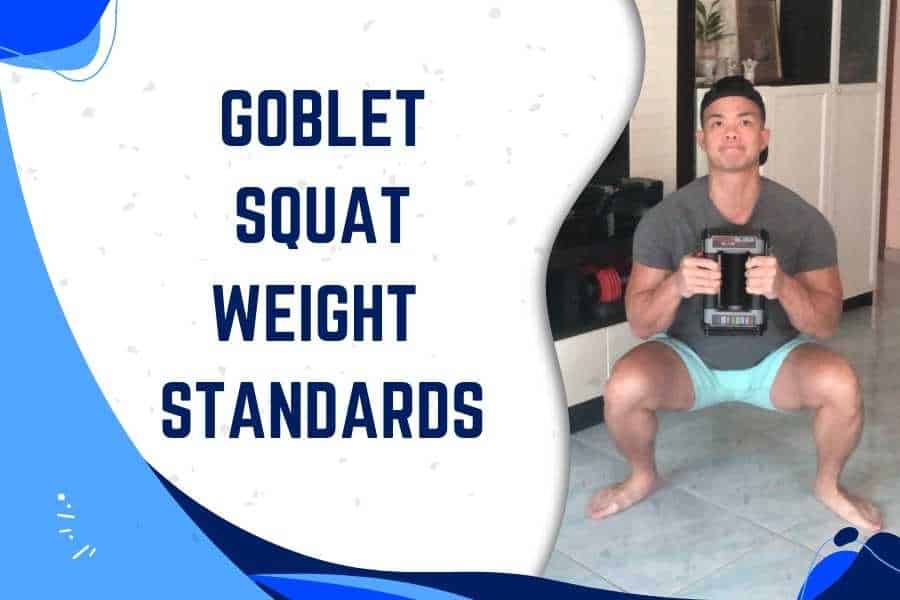Everyone has different fitness levels which determine the ideal weight they should be lifting for workouts. Below, I share goblet squat weight standards that allow you to benchmark performance against yourself as well as other people.
A respectable goblet squat for the average beginner is around 15% of the individual’s body weight for a single repetition. Intermediates should be able to lift 45% of their body weight, and advanced lifters should be able to lift 65% of their body weight.
The weight standards in this post will help you determine what is a respectable weight to be squatting and how much weight you should be lifting based on your gender, body weight, and training experience.
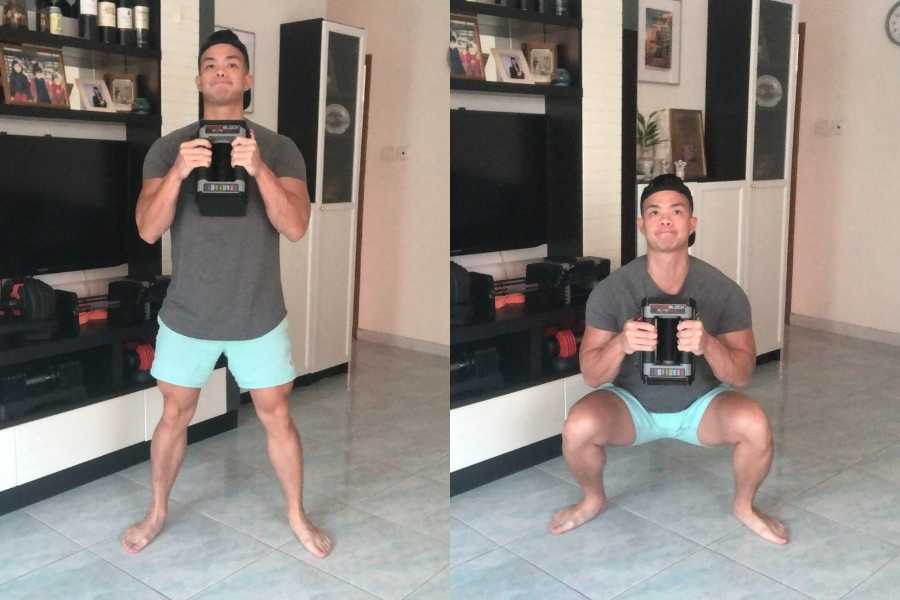
- How To Use These Goblet Squat Weight Standards
- Beginner Goblet Squat Weight Standards
- Intermediate Goblet Squat Weight Standards
- Advanced Goblet Squat Weight Standards
- How Good Is Your Goblet Squat Vs Others?
- Factors Affecting How Much Weight You Can Goblet Squat
- 5 Reasons Why Your Goblet Squat Weight Is Below Average
- 5 Tips To Improve Your Goblet Squat Weight
- Other Weight Standards For Goblet Squat Muscles
- Conclusion
How To Use These Goblet Squat Weight Standards
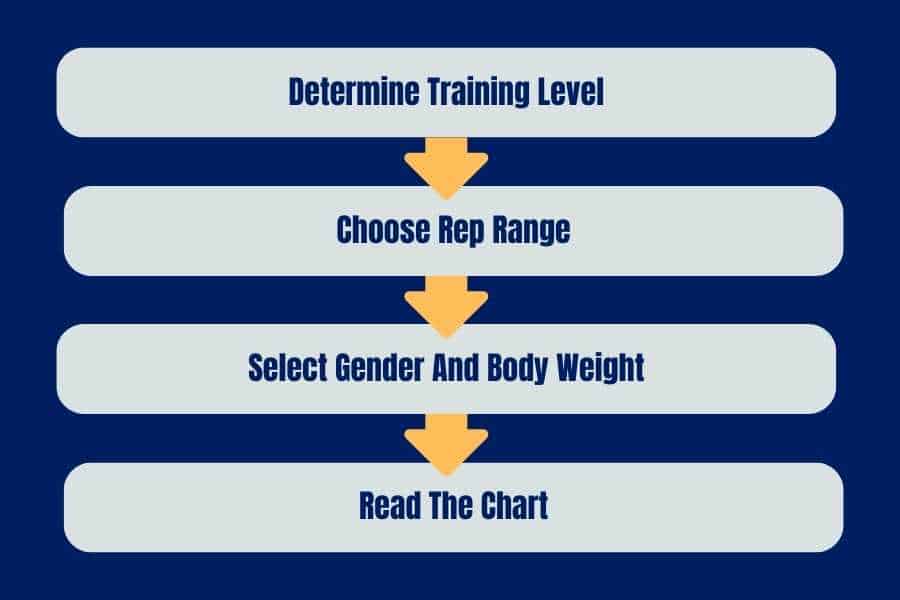
1) Determining your training level:
- Beginners have practiced an exercise for 1-12 months.
- Intermediates have practiced an exercise for 12-36 months.
- Advanced lifters have practiced an exercise for 4 years or more.
2) Choosing your rep range:
The weight standards are given for:
- 1-rep max (1RM)- this is the maximum amount of weight you can lift for a single repetition. It’s often used as a strength standard.
- 8-12 working reps- this is generally considered to be the ideal rep range for building muscle.
3) Selecting your gender and body weight:
- Goblet squat weight standards are revealed for common body weights.
- Male goblet squat weight standards are given.
- Females can use a 75% conversion (multiply the weight standard by 0.75).
4) Reading the charts:
- Weight standards are given as lbs on the top and kg on the bottom.
- If you’re lifting at or above the weight standard for your given training level, body weight, and gender, then you are lifting a respectable amount of weight.
Beginner Goblet Squat Weight Standards
Here’s how much weight you should be lifting on the goblet squat as a beginner:
| Bodyweight | 1-rep max | 8-reps | 9-reps | 10-reps | 11-reps | 12-reps |
|---|---|---|---|---|---|---|
| 120lb 54kg | 15lb 7kg | 13lb 6kg | 12lb 6kg | 12lb 5kg | 11lb 5kg | 10lb 5kg |
| 150lb 68kg | 24lb 10kg | 18lb 8kg | 18lb 8kg | 17lb 8kg | 16lb 7kg | 15lb 7kg |
| 200lb 91kg | 35lb 15kg | 27lb 12kg | 27lb 12kg | 25lb 11kg | 23lb 11kg | 22lb 10kg |
| 250lb 113kg | 45lb 20kg | 35lb 16kg | 34lb 16kg | 32lb 15kg | 30lb 14kg | 29lb 13kg |
| 300lb 136kg | 55lb 24kg | 43lb 20kg | 42lb 19kg | 39lb 18kg | 37lb 17kg | 35lb 16kg |
Generally speaking, beginners should be able to goblet squat 10 to 20% of their body weight for a single repetition (1-rep max).
Unsure whether or not to include squats in your program? You can check out my other post for a full explanation of the full benefits of squatting!
Intermediate Goblet Squat Weight Standards
Here’s how much weight you should be lifting on the goblet squat as an intermediate lifter:
| Bodyweight | 1-rep max | 8-reps | 9-reps | 10-reps | 11-reps | 12-reps |
|---|---|---|---|---|---|---|
| 120lb 54kg | 70lb 31kg | 55lb 25kg | 54lb 24kg | 50lb 23kg | 48lb 22kg | 45lb 20kg |
| 150lb 68kg | 82lb 38kg | 66lb 30kg | 65lb 29kg | 61lb 27kg | 57lb 26kg | 54lb 24kg |
| 200lb 91kg | 102lb 47kg | 82lb 37kg | 80lb 36kg | 75lb 34kg | 71lb 32kg | 67lb 30kg |
| 250lb 113kg | 119lb 54kg | 96lb 44kg | 94lb 42kg | 88lb 40kg | 83lb 38kg | 78lb 35kg |
| 300lb 136kg | 136lb 61kg | 108lb 49kg | 105lb 48kg | 99lb 45kg | 93lb 42kg | 88lb 40kg |
Generally speaking, intermediates should be able to goblet squat 40 to 60% of their body weight for a single repetition.
Advanced Goblet Squat Weight Standards
Here’s how much weight you should be lifting on the goblet squat as an advanced lifter :
| Bodyweight | 1-rep max | 8-rep max | 9-rep max | 10-rep max | 11-rep max | 12-rep max |
|---|---|---|---|---|---|---|
| 120lb 54kg | 111lb 50kg | 88lb 40kg | 86lb 39kg | 80lb 36kg | 76lb 34kg | 72lb 32kg |
| 150lb 68kg | 129lb 58kg | 102lb 46kg | 100lb 45kg | 93lb 42kg | 88lb 40kg | 83lb 38kg |
| 200lb 91kg | 152lb 69kg | 122lb 55kg | 119lb 54kg | 111lb 50kg | 105lb 48kg | 99lb 45kg |
| 250lb 113kg | 171lb 78kg | 138lb 63kg | 135lb 61kg | 126lb 57kg | 119lb 54kg | 112lb 51kg |
| 300lb 136kg | 190lb 87kg | 153lb 69kg | 149lb 68kg | 139lb 63kg | 132lb 60kg | 124lb 56kg |
Generally speaking, an advanced lifter should be able to goblet squat 60 to 90% of their body weight for a single repetition.
How Good Is Your Goblet Squat Vs Others?
Here’s the percentage of people who can goblet squat their own body weight:
| Goblet Squat 1RM Weight (as a fraction of body weight) | % Of People Who Can Do It |
|---|---|
| 0.05x | 100% |
| 0.10x | 99% |
| 0.15x | 96% |
| 0.20x | 93% |
| 0.25x | 88% |
| 0.30x | 82% |
| 0.35x | 75% |
| 0.40x | 68% |
| 0.45x | 60% |
| 0.50x | 52% |
| 0.55x | 45% |
| 0.60x | 38% |
| 0.65x | 32% |
| 0.70x | 26% |
| 0.75x | 21% |
| 0.80x | 17% |
| 0.85x | 13% |
| 0.90x | 10% |
| 0.95x | 8% |
| 1.00x | 6% |
This allows you to compare your standards with others.
To calculate your goblet squat as a fraction of your own body weight, simply divide the weight of your goblet squat 1RM by your body weight.
For example: if you weigh 150lbs and your goblet squat 1RM is 75lbs, then you’re lifting 0.50x your body weight (75lbs ÷ 150lbs).
The above chart indicates:
- 75% of people can goblet squat 0.35x their body weight for 1 rep. This represents the lower quartile of lifters and is a respectable weight for beginners to achieve.
- 50% of people can goblet squat 0.50x their body weight for 1 rep. This represents the median quartile of lifters and is a respectable weight for intermediates to achieve. It’s also a realistic target for beginners to aim towards with enough training.
- 25% of people can goblet squat 0.70x their body weight for 1 rep. This represents the upper quartile of lifters and is a respectable weight for advanced lifters. It’s also a realistic target for intermediates to aim towards with enough training.
Factors Affecting How Much Weight You Can Goblet Squat
3 factors affect how much weight you can lift on a goblet squat:
- Training Level. The longer you’ve been practicing the goblet squat the more weight you can lift.
- Gender. Men have more muscle mass and can generally squat more than women.
- Body weight. The heavier you are the more weight you can squat. That’s because body weight has a positive correlation with muscle mass and strength.
- Rep range. The fewer reps you do the more weight you can squat.
5 Reasons Why Your Goblet Squat Weight Is Below Average
Here are 5 common reasons why you may find the goblet squat difficult to perform and why your weight standards are below average:
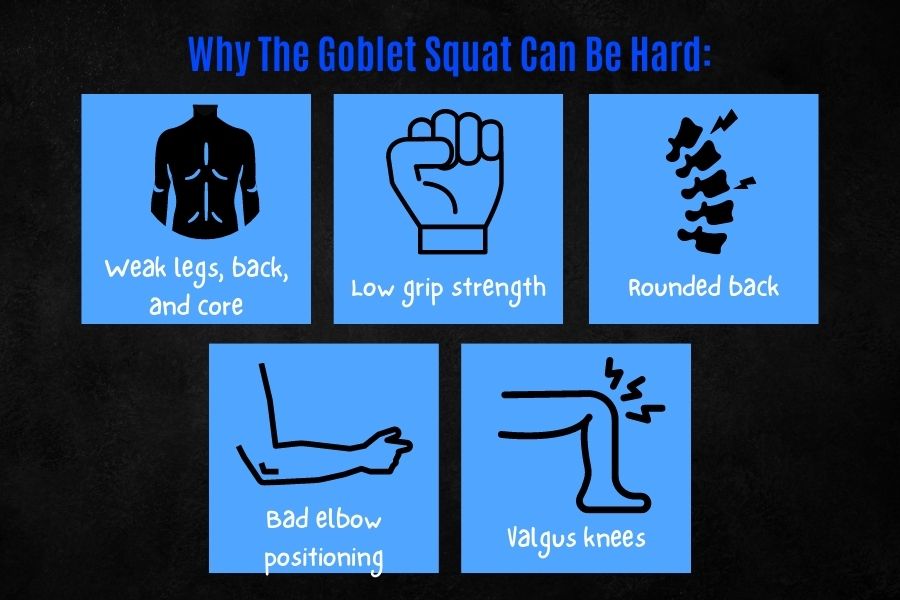
1) Weak quadriceps, posterior chain, or core muscles
The goblet squat is a quad-dominant exercise, mainly engaging the quadriceps. But the posterior chain (hamstrings, glutes, and lower back) and core are also engaged to stabilize the movement.
Weakness in any of these muscles can negatively impact your goblet squat strength.
The solution is to either simply do more goblet squats or focus on isolation-type movements that strengthen the target muscles.
2) Low grip strength
Unlike many other squat variations, the goblet squat places a lot of emphasis on grip strength because you need to be able to hold a dumbbell to perform the movement.
Therefore a weak grip represents a major choke point in goblet squat progression.
Thankfully, your grip strength should improve the more you perform this exercise and the more you progress through heavier loads.
3) Your back is not straight
It’s important to keep a straight back (angled vertically and running parallel with the shins) during the goblet squat.
One of the most detrimental mistakes is to let your back arch forward. This is bad for two reasons.
Firstly, a curved back increases injury risk.
Secondly, leaning forward limits the amount of weight you can lift on the squat because force cannot be efficiently transferred from your feet to the dumbbell.
Keeping your chest up, head facing forward, and shoulder blades squeezed backward can help a lot to prevent rounding of the back.
You can also try including dumbbell deadlifts into your program to strengthen the lower back.
4) Incorrect elbow positioning
The elbows should be tucked tightly towards the torso in the goblet squat- imagine you’re trying to use them to clasp two books against the ribcage.
This braces the squat and allows you to hold the dumbbell firmly against your chest.
Keeping your elbows tight towards the body also means they won’t bump into your inner thighs as you sink down during the squat. And this allows you to drop deeper and maximally engage your leg muscles.
5) Inward knee caving.
Valgus knees describe the inward caving of your knees during a squat. It’s common in beginners who have yet to develop squatting strength.
Not only do valgus knees increase injury risk, but it also limits the amount of weight you can squat since you cannot transfer full power from your legs to the dumbbell.
So how can you prevent valgus knees?
I like to stance my feet just wider than shoulder-width apart, open my hips, and point both feet slightly outwards. Make an active effort to keep the knees pointed outwards throughout the squat.
5 Tips To Improve Your Goblet Squat Weight
Here are 5 tips to improve your goblet squat strength to build bigger and stronger legs:
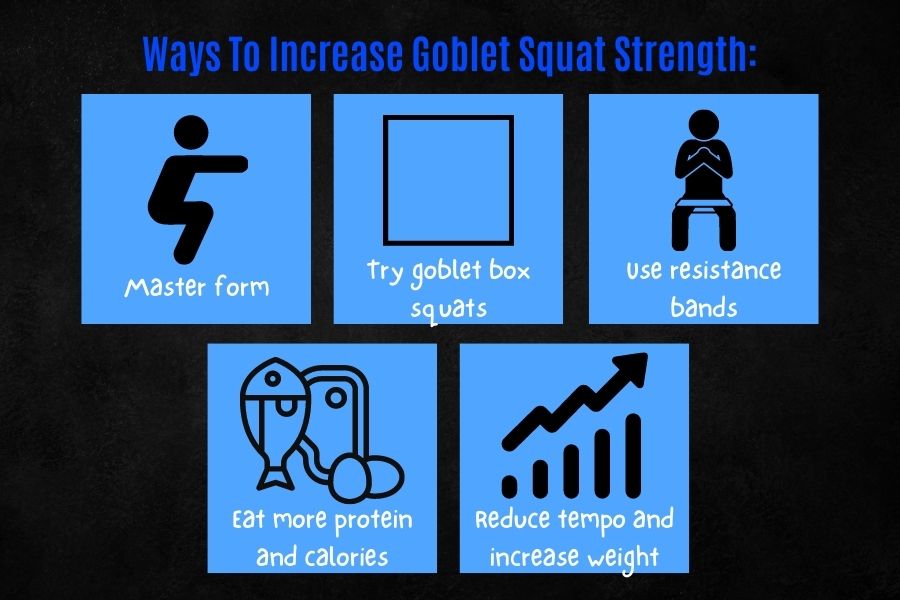
1) Perfect your form to maximize leg muscle activation.
Applying correct form nuances results in greater muscle activation in your legs. And this is one of the best ways to promote strength and muscle gains.
My top tip is to concentrate on achieving sufficient depth. Your buttocks don’t have to reach the floor to get the most benefits from a goblet squat, but your thighs should reach parallel to the floor.
2) Try goblet box squats to train explosive leg strength.
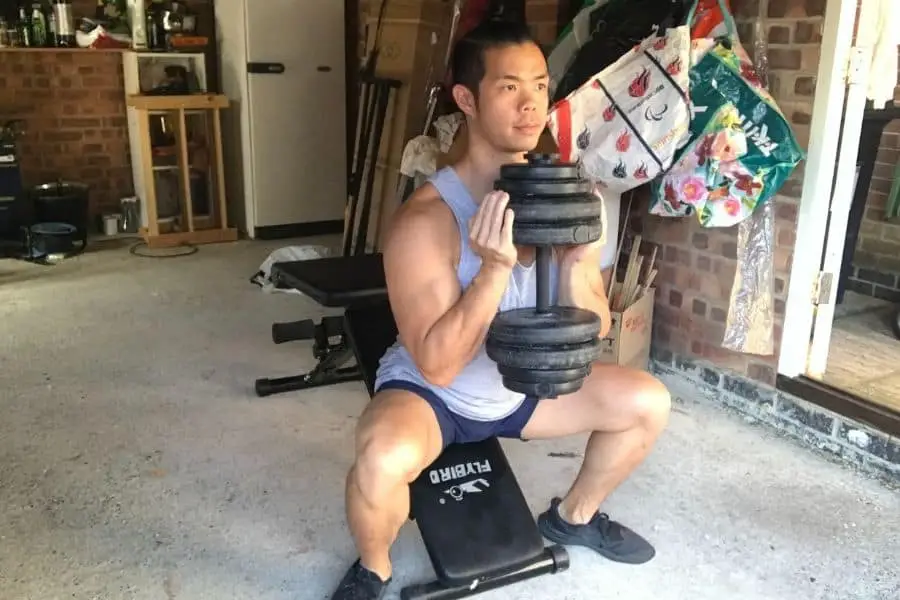
Box squats are a great alternative to the goblet squat for people who are struggling to achieve sufficient depth.
Here, you’re basically goblet squatting down onto a box or weight bench. The box/bench provides support and stops your buttocks from sinking too low.
Once your butt reaches the box, you can then explode back up.
Once you get comfortable with traditional box goblet squats, you can even introduce a 1-second pause at the bottom to make the exercise that much more challenging.
The pause can also help build explosive squat strength. And the assistance allows you to safely lift more weight, go low, and train explosive power in the legs.
3) Use resistance bands to fix valgus knees

Try using resistance bands if valgus knees are limiting your goblet squat weight.
This method forces you to push your knees outwards against the band, thereby preventing your knees from caving inwards.
Resistance bands can also be used directly to perform home workouts to build muscle.
4) Get sufficient nutrition and rest to fuel leg development
All the training in the world won’t provide any return any gains if you’re not eating enough protein and calories.
If your goblet squat has been stagnating, then it’s worth looking at your nutrition. The ideal bulking diet for muscle growth requires at least 1g of protein and a 5-15% caloric surplus every day.
For details on how to bulk up, you can check out my guide on gaining your first 10 pounds of muscle.
In addition to a bulking diet, you should also make sure you give your legs sufficient rest between workouts.
Ideally, allow your lower body to rest for at least 24-48 hours before training again.
5) Decrease tempo and increase load when you are ready.
Once you’ve nailed your goblet squat form, you should find ways to increase intensity. This provides more muscle stimulation and drives leg strength gains.
The best way to do this is to reduce your squat tempo and apply progressive overload every week.
To reduce the tempo, I like to count 4 seconds up and 4 seconds down for each rep.
Regarding progressive overload, I’d recommend adding 5lbs to your squat each week.
But only do this when you can do all your current reps with good form.
Other Weight Standards For Goblet Squat Muscles
Goblet squats are a lower-body compound movement that works the quads, hamstrings, calves, and glutes. Here are weight standards for other exercises that hit similar muscle groups:
- Dumbbell deadlift– full-body exercise with emphasis on the hamstrings, glutes, and lower back.
- Dumbbell squat– alternative to the goblet squat for overall leg development.
You can also check out my other post for the world’s heaviest squats!
Conclusion
I’ve shared my goblet squat weight standards for people of different genders, body weights, and training levels.
You’re lifting a respectable amount of weight if you meet or exceed these standards.
I’ve also shared my tips on how to improve a sub-average goblet squat.
You may also be interested in the downloadable Kalibre Blueprint PDF which details exactly how I gained 40lbs of lean muscle (it’s 100% free!). It details the exact exercises and nutrition (with printables) I used to go from skinny to ripped!

